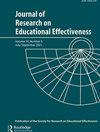A Chain as Strong as Its Strongest Link? Understanding the Causes and Consequences of Biases Arising from Selective Analysis and Reporting of Research Results
IF 1.6
4区 教育学
Q2 EDUCATION & EDUCATIONAL RESEARCH
Journal of Research on Educational Effectiveness
Pub Date : 2023-07-18
DOI:10.1080/19345747.2023.2219673
引用次数: 0
Abstract
This is a big problem in applied statistics in general and education policy in particular. For example, the respected economist James Heckman and his colleagues have claimed (Garcia et al., 2016) that, for a certain early childhood intervention, “The overall rate of return is 13.7% per annum, and the benefit/cost ratio is 7.3.” That quoted sentence has two serious problems related to uncertainty and selection bias. To start with, it is an elementary but important error to have written that “the overall rate of return is . . . the benefit/cost ratio is . . .”; each instance of the word “is” in that sentence should immediately have been followed by “estimated at.” The next step is to recognize that selection on statistical significance induces biases in these estimates— and, given the small samples, high variabilities, and researcher degrees of freedom in the studies where the estimates came from, the biases could be huge (Gelman, 2017a). The report with its bold claims neither acknowledged this bias nor made any attempt to assess its magnitude.链条有最坚固的一环那么坚固?了解因选择性分析和报告研究结果而产生的偏差的原因和后果
这是应用统计中的一个大问题,特别是在教育政策中。例如,受人尊敬的经济学家James Heckman和他的同事声称(Garcia et al., 2016),对于某种早期儿童干预,“总体回报率为每年13.7%,收益/成本比为7.3。”引用的那句话有两个与不确定性和选择偏差有关的严重问题。首先,写“总回报率是……”是一个基本但重要的错误。收益/成本比是……”;在这个句子中,“is”这个词的每一个实例后面都应该紧跟着“estimated at”。下一步是要认识到,对统计显著性的选择会导致这些估计中的偏差——而且,考虑到样本小,变异性高,以及研究人员在估计来自的研究中的自由度,偏差可能是巨大的(Gelman, 2017a)。这份大胆宣称的报告既没有承认这种偏见,也没有试图评估其严重程度。
本文章由计算机程序翻译,如有差异,请以英文原文为准。
求助全文
约1分钟内获得全文
求助全文
来源期刊

Journal of Research on Educational Effectiveness
EDUCATION & EDUCATIONAL RESEARCH-
CiteScore
4.00
自引率
11.10%
发文量
37
期刊介绍:
As the flagship publication for the Society for Research on Educational Effectiveness, the Journal of Research on Educational Effectiveness (JREE) publishes original articles from the multidisciplinary community of researchers who are committed to applying principles of scientific inquiry to the study of educational problems. Articles published in JREE should advance our knowledge of factors important for educational success and/or improve our ability to conduct further disciplined studies of pressing educational problems. JREE welcomes manuscripts that fit into one of the following categories: (1) intervention, evaluation, and policy studies; (2) theory, contexts, and mechanisms; and (3) methodological studies. The first category includes studies that focus on process and implementation and seek to demonstrate causal claims in educational research. The second category includes meta-analyses and syntheses, descriptive studies that illuminate educational conditions and contexts, and studies that rigorously investigate education processes and mechanism. The third category includes studies that advance our understanding of theoretical and technical features of measurement and research design and describe advances in data analysis and data modeling. To establish a stronger connection between scientific evidence and educational practice, studies submitted to JREE should focus on pressing problems found in classrooms and schools. Studies that help advance our understanding and demonstrate effectiveness related to challenges in reading, mathematics education, and science education are especially welcome as are studies related to cognitive functions, social processes, organizational factors, and cultural features that mediate and/or moderate critical educational outcomes. On occasion, invited responses to JREE articles and rejoinders to those responses will be included in an issue.
 求助内容:
求助内容: 应助结果提醒方式:
应助结果提醒方式:


